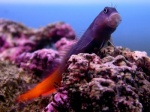New Fish
Page 1 of 1
 New Fish
New Fish
Tasmanian Scientists Name 9 New Rare (and Threatened) Handfish
By CORAL Editors - Posted on 27 July 2010
 The Red Handfish, Brachionichthys politus, walks on its stout pectorial fins, but is listed as vulnerable and is under pressure from habitat degradation and collection. Image credit: CSIRO.
The Red Handfish, Brachionichthys politus, walks on its stout pectorial fins, but is listed as vulnerable and is under pressure from habitat degradation and collection. Image credit: CSIRO.
Fifty million-years ago, they ambled across the floors of the world's oceans, but now only exist off off Tasmania and in eastern and southern Australia.
Handfishes are a type of small, often strikingly patterned and sometimes vividly colouful bottom-dwelling marine fish that tend to "walk" on the seabed on hand-like fins, rather than swim. They are members of the Brachionichthyidae, a small family related to the Antennariidae or frogfishes and anglerfishes. The temperate waters where they are found may range from 50-70ºF (10-21ºC).
There are only 14 known species of handfish, nine of which were described recently. These new species are in the same family as the already endangered Spotted Handfish and are described in a review of the handfish family by Daniel Gledhill, far left, and Dr. Peter Last, near left, Hobart-based fish taxonomists from the CSIRO Wealth from Oceans Flagship.

The endangered Spotted Handfish, Brachionichthys hirsutus, are found on sandy sediments at the bottom of Tasmania's Derwent estuary and adjoining bays. Image credit:CSIRO
Six of the curious little fishes are found only in Tasmania and one is known from only one specimen possibly collected in Tasmania by early European explorers, yet not recorded since. It also deepens concerns among Australian scientists and naturalists about declining populations of some handfishes.
Scientists are alarmed at the relatively rapid disappearance of the handfishes in recent years. "There is evidence of shallow-water species disappearing quickly, from being common in certain areas a few decades ago, to apparently being locally extinct in some areas‚ says
Dr. Peter Last.
"Handfishes are extremely vulnerable to environmental change, introduced species, pollution, siltation, fishing, sea-temperature rise and coastal development—due to their scarcity, patchy distribution, life history strategy, low breeding rates and poor dispersal ability."

Pair of Zeibell's Handfish, Sympterichthys moultoni, is restricted to isolated populations off eastern and southern Tasmania. Image credit: Andrew Maver
"It is not just two or three handfish that are species of concern. Our work has described nine new species, each with its own environmental niches and needs, and several of these appear to have very restricted distributions, and/or occur in very low abundance."
(The Spotted Handfish is listed as endangered under the Environment Protection and Biodiversity Conservation Act 1999 and the Red Handfish and Ziebell's Handfish are listed as vulnerable.)
"They are of great importance to understanding the origins of Australian marine life, the role of Australia as a refuge during previous periods of change, and the effects on living species of habitat alteration and rapid climate change," says team member Daniel Gledhill.
Mr. Gledhill says the handfishes have proven difficult to classify due to their rarity and a lack of specimens.

The Pink Handfish, Brachiopsilus dianthus, is known from only four specimens and was last recorded off the Tasman Peninsula in 1999. Image credit: Karen Gowlett-Holmes
One of the newly named species, the Pink Handfish, is known from only four specimens and was last recorded off the Tasman Peninsula in 1999.
SOURCES: From materials released by CSIRO, May, 2010.
CSIRO initiated the National Research Flagships to provide science-based solutions to Australia's major research challenges and opportunities. The 10 Flagships form multidisciplinary teams with industry and the research community.
The Marine Biodiversity Hub is a collaborative partnership funded by the Commonwealth Environment Research Facilities program, an Australian Government initiative supporting world class, public good research. Its partners include Tasmanian Fisheries and Aquaculture Institute, University of Tasmania; CSIRO Wealth from Oceans National Flagship; Geoscience Australia; Australian Institute of Marine Science; and Museum Victoria.
Zootaxa 2252: 1–77 (2009)
By CORAL Editors - Posted on 27 July 2010
 The Red Handfish, Brachionichthys politus, walks on its stout pectorial fins, but is listed as vulnerable and is under pressure from habitat degradation and collection. Image credit: CSIRO.
The Red Handfish, Brachionichthys politus, walks on its stout pectorial fins, but is listed as vulnerable and is under pressure from habitat degradation and collection. Image credit: CSIRO.Fifty million-years ago, they ambled across the floors of the world's oceans, but now only exist off off Tasmania and in eastern and southern Australia.
Handfishes are a type of small, often strikingly patterned and sometimes vividly colouful bottom-dwelling marine fish that tend to "walk" on the seabed on hand-like fins, rather than swim. They are members of the Brachionichthyidae, a small family related to the Antennariidae or frogfishes and anglerfishes. The temperate waters where they are found may range from 50-70ºF (10-21ºC).

There are only 14 known species of handfish, nine of which were described recently. These new species are in the same family as the already endangered Spotted Handfish and are described in a review of the handfish family by Daniel Gledhill, far left, and Dr. Peter Last, near left, Hobart-based fish taxonomists from the CSIRO Wealth from Oceans Flagship.

The endangered Spotted Handfish, Brachionichthys hirsutus, are found on sandy sediments at the bottom of Tasmania's Derwent estuary and adjoining bays. Image credit:CSIRO
Six of the curious little fishes are found only in Tasmania and one is known from only one specimen possibly collected in Tasmania by early European explorers, yet not recorded since. It also deepens concerns among Australian scientists and naturalists about declining populations of some handfishes.
Scientists are alarmed at the relatively rapid disappearance of the handfishes in recent years. "There is evidence of shallow-water species disappearing quickly, from being common in certain areas a few decades ago, to apparently being locally extinct in some areas‚ says
Dr. Peter Last.
"Handfishes are extremely vulnerable to environmental change, introduced species, pollution, siltation, fishing, sea-temperature rise and coastal development—due to their scarcity, patchy distribution, life history strategy, low breeding rates and poor dispersal ability."

Pair of Zeibell's Handfish, Sympterichthys moultoni, is restricted to isolated populations off eastern and southern Tasmania. Image credit: Andrew Maver
"It is not just two or three handfish that are species of concern. Our work has described nine new species, each with its own environmental niches and needs, and several of these appear to have very restricted distributions, and/or occur in very low abundance."
(The Spotted Handfish is listed as endangered under the Environment Protection and Biodiversity Conservation Act 1999 and the Red Handfish and Ziebell's Handfish are listed as vulnerable.)
"They are of great importance to understanding the origins of Australian marine life, the role of Australia as a refuge during previous periods of change, and the effects on living species of habitat alteration and rapid climate change," says team member Daniel Gledhill.
Mr. Gledhill says the handfishes have proven difficult to classify due to their rarity and a lack of specimens.

The Pink Handfish, Brachiopsilus dianthus, is known from only four specimens and was last recorded off the Tasman Peninsula in 1999. Image credit: Karen Gowlett-Holmes
One of the newly named species, the Pink Handfish, is known from only four specimens and was last recorded off the Tasman Peninsula in 1999.
SOURCES: From materials released by CSIRO, May, 2010.
CSIRO initiated the National Research Flagships to provide science-based solutions to Australia's major research challenges and opportunities. The 10 Flagships form multidisciplinary teams with industry and the research community.
The Marine Biodiversity Hub is a collaborative partnership funded by the Commonwealth Environment Research Facilities program, an Australian Government initiative supporting world class, public good research. Its partners include Tasmanian Fisheries and Aquaculture Institute, University of Tasmania; CSIRO Wealth from Oceans National Flagship; Geoscience Australia; Australian Institute of Marine Science; and Museum Victoria.
Zootaxa 2252: 1–77 (2009)
- Last, P.R.; Gledhill, D.C. 2009: A revision of the Australian handfishes (Lophiiformes: Brachionichthyidae), with descriptions of three new genera and nine new species. Zootaxa, 2252: 1-77. Abstract & excerpt PDF

HSCmember- Great White

- Location : Bemidji
Number of posts : 560
Page 1 of 1
Permissions in this forum:
You cannot reply to topics in this forum|
|
|

 Home
Home